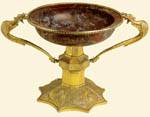|
|
| Byzantine Minor Arts |
14th c., 2nd half Vatopedi Monastery Carved jasper, gilded silver relief work Height 19.5 cm, rim diameter 20.5 cm, with handles 32 cm., base diameter 17 cm |
|

|
This chalice, known as the 'Jasper', is considered one of the most characteristic products of Byzantine silver-work, and one of the finest pieces from the Palaeologan period. It belonged to Manuel Cantacuzenos Palaeologos (1349-80), Despot of Mystra, son of the Emperor John VI Cantacuzenos (1347-54) and grandson of Theodore Palaeologos, Despot of Mystra. A text from 1570 mistakenly ascribes it to the Emperor Manuel Palaeologos (1391-1425), with the result that it has been associated with his son Andronikos, Despot of Thessaloniki (1408-23), who retreated to the Monastery of Vatopedi (Loverdou-Tsigarida 1996, pp. 475 and 655 n. 110). This account has misled a number of serious scholars. The cup of the chalice was carved out of a single piece of jasper, and given the shape of an antique broad-lipped wine-cup in a Byzantine workshop. The edge of the lip was later embellished with an inscribed mount of obviously western inspiration, while an annular device of similar style was added to the foot. The inscription on the rim is the familiar prayer from the Eucharist as given in the Liturgy of St Basil: 'and he gave it to his disciples and apostles saying, drink of this, all of you ...'. This proves that, after the mount was added, the cup was used as an ecclesiastical vessel. Its initial use may well have been secular: this is reflected in the tradition associating it with cures performed on victims of poisons and with protection against poisoned beverages. The case of older vessels which have been mounted before reused is familiar from certain imperial chalices, such as that belonging to the Emperor Romanos (10th c.), which has a sardonyx cup dating from the first century BC (Trιsor de Saint Marc 1984, no. 10, p. 129). The base is octagonal, its eight sections decorated with medallions containing, alternately, cruciform monograms and half-length hierarchs holding open scrolls. The monograms identify the owner of the vessel: M (Manuel), Δ (Despot), Κ (Cantacuzenos), Π (Palaeologos). The hierarchs represented are Sts Athanasios, Basil, John Chrysostom and Gregory the Theologian. The iconographic types of these hierarchs follow Byzantine models, and their presence on the vessel is linked to its use in, and their association with, the rite of the Holy Eucharist. Both base and foot have been decorated in champlevι technique, combined with low relief for the depiction of the medallion subjects. The stippled background creates a colour contrast which further sets off the motifs. Another interesting feature is the octagonal annular device halfway down the foot, decorated with medallions containing - alternately - mythological beasts and cross-shaped rinceau. The dragon-lions, a motif particularly beloved of the Byzantines, are found on thirteenth- and fourteenth-century manuscripts, jewellery, metalware, fabrics and sculptures (Loverdou-Tsigarida 1996, pp. 477 and 656 n. 122), always in a purely decorative role without any underlying symbolism. This chalice also has handles in the shape of winged dragons, connecting the rim and the foot. This feature was thought to be of Gothic inspiration (Volbach - Lafontaine-Dosogne 1968, p. 201), but it is also found in Venetian work, including fourteenth- and fifteenth-century reliquaries like the 'kratetera' in the Monastery of Vatopedi (no. 9.33). These creatures, represented with their wings folded in repose, have long and extremely elegant tails which terminate in a second head, a detail which accents their decorative role. This marvellous work of art, an example of the fine silvercraft of the Late Byzantine period, proves that a judicious marriage of Gothic and classical Byzantine elements could produce truly exquisite results.
| |
|
Bibliography: Uspenskij 1880, pp. 31-3. Barskij 1885, p. 201. Kondakov 1902, p. 220. Smyrnakis 1903, pp. 439-40. Millet - Pargoire - Petit 1904, p. 23. Dalton 1911, p. 562. Diehl 1926, pp. 898-9. Doelger - Weigand 1943, p. 156. Bank 1970, p. 341. Economaki-Papadopoulou 1980, p. 11. Byzance 1992, p. 427. Loverdou-Tsigarida 1996, pp. 475-7, figs. 420-5.
| ||
| K. L-T. | ||
| Index of exhibits of Monastery of Vatopedi 14th century |
||
Reference address : https://www.elpenor.org/athos/en/e218ci14.asp